| Sphodromantis lineola | |
|---|---|
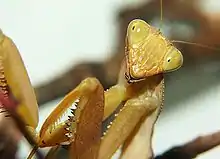 | |
| Scientific classification | |
| Domain: | Eukaryota |
| Kingdom: | Animalia |
| Phylum: | Arthropoda |
| Class: | Insecta |
| Order: | Mantodea |
| Family: | Mantidae |
| Genus: | Sphodromantis |
| Species: | S. lineola |
| Binomial name | |
| Sphodromantis lineola (Burmeister, 1838) | |
Sphodromantis lineola, common name African mantis or African praying mantis, is a species of praying mantis from Africa sometimes raised in captivity.[1][2][3][4] S. lineola is often colored green, however they can also be colored different types of brown. The brown colored individuals have also been observed with purple colored eyes.[5] It may be distinguished from S. baccettii by the absence of blue-black spots on its forearms.[6]
Visual System
The visual system of the S. lineola is the most studied aspect of this species. In fact, this species is the most studied in this topic. Since S. lineola are sit and wait predators they have a well developed motion detection visual system. This species of mantis like most other species have apposition based compound eyes and mantises are the only invertebrates known to use stereoscopic vision. They use looming signals in order to detect and calculate other organisms or objects heading towards them using motion-in-depth perception. Using this system they are able to calculate based on speed whether to resort to predatory or defensive strikes. They also have also demonstrated to respond to visual cues which are not of their usual prey or that they have ever encountered which complements their larger range of prey due to scarcity in nature. However some studies do denote that there is no evidence of this species being able to judge the size of their prey and mostly just focus on their depth, which can probably be connected to their generalist predatory behavior.[7][8][9][10][11]
Predation
Much Like the rest of the mantids they are mainly insectivores preying on other insects. However, Mantids are also known to be able to capture and feed on vertebrates. These ferocious predators are not picky predators and are very opportunistic. This is due to the fact that in nature prey is scarce and are often in a state of hunger. Hence, why female mantids including this species will resort to post mating cannibalism to supplement the energy and nutrition needed to survive and reproduce.[12] Like most praying mantis this species is an ambush predator. They use their well developed motion detection visual systems as well as proprioceptive information to detect prey and then deliver a carefully calculated and extremely accurate strike.[13][14]
Reproduction
Mate Attraction
Males are mainly attracted to females through olfactory and visual signals as well as with tactile cues. Studies have shown that hormones alone are not responsible for attraction of males by females. Females must perform mainly specific antennal movements as a premating behavior along with hormones in order to attract the attention of the males.[15]
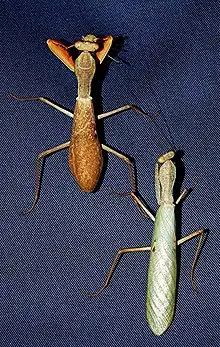
Sexual Cannibalism
Many mantid species are known to show cannibalism post copulation, S. lineola being one of this species.[16] Studies have come to the conclusion that this behavior can be attributed female mantids needing nutrition in order to produce more offspring. It has been documented that females of this species are commonly in a state of hunger in natural settings which is shown to be a driver of this behavior. In captivity, under circumstances in which females are well fed, they have shown to not perform cannibalism on the male mantid after copulation. Other ways for males to avoid being eaten by their mate is through different courtship behaviors such as sneaking on the female or swiftly jumping on their back whilst trying to avoid being eaten. Although under most natural circumstances these are often ineffective.[16]
Scientific Relevance
S. lineola is being used for many different studies most of which involving its visual system. Their ability to be kept in captivity has allowed them to become a very used species in this field. They have contributed in the field for theories and topics like the flicker effect idea; the effect of invisible noise on insect motion detection; motion-in-depth perception of mantises; reaction to different stimuli; the physiology of the mantis eye and many other studies based around their vision. They are considered to be the most studied species of mantis in this field.[7][8][9][10][11][13][17] Similarly, this has also led to the study of the mechanisms of mantis predatory behaviors and responses to prey. Furthermore, this species has also been used to study the sexual cannibalism behavior seen so often in mantids as well as helping identify the first putative pheromone in a praying mantid.[15]
Gallery
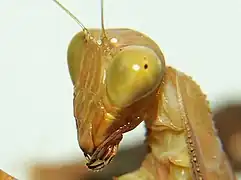 Sphrodomantis lineola
Sphrodomantis lineola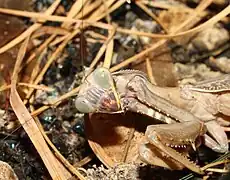 Sphodromantis lineola
Sphodromantis lineola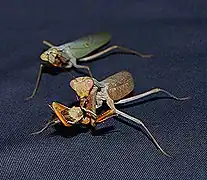 Sphodromantis lineola
Sphodromantis lineola
References
- ↑ "African Mantis". Archived from the original on 2009-03-30.
- ↑ "TrekNature - Alien Invader Photo". www.treknature.com.
- ↑ "African Lined Mantis - Sphodromantis lineola". www.exotic-pets.co.uk.
- ↑ African Praying Mantis Sphodromantis gastrica, lineola, viridis and centralis Archived 2009-09-16 at the Wayback Machine
- ↑ "Keepinginsects - African Mantis". www.keepinginsects.com. 5 March 2011.
- ↑ "Alles over insecten en ongewervelden als huisdier". Ongewoon Ongewerveld (in Dutch).
- 1 2 Nityananda, V.; Joubier, C.; Tan, J.; Tarawneh, G.; Read, J. C. A. (2019). "Motion-in-depth perception and prey capture in the praying mantis Sphodromantis Lineola". Journal of Experimental Biology. 222 (Pt 11). doi:10.1242/jeb.198614. PMID 31064852. S2CID 91490401.
- 1 2 Prete, F. R.; Hurd, L. E.; Branstrator, D.; Johnson, A. (2002). "Responses to computer-generated visual stimuli by the male praying mantis, Sphodromantis Lineola (Burmeister)". Animal Behaviour. 63 (3): 503–510. doi:10.1006/anbe.2001.1955. S2CID 53220599.
- 1 2 Nityananda, V.; Bissianna, G.; Tarawneh, G.; Read, J. C. A. (2016). "Small or far away? Size and distance perception in the praying mantis". Philosophical Transactions of the Royal Society B. 371 (1697). doi:10.1098/rstb.2015.0262. PMC 4901456. PMID 27269605.
- 1 2 Popkiewicz, B.; Prete, F. R. (2013). "Macroscopic characteristics of the praying mantis electroretinogram". Journal of Insect Physiology. 59 (8): 812–823. doi:10.1016/j.jinsphys.2013.05.002.
- 1 2 Umeton, D.; Tarawneh, G.; Fezza, E.; Read, J. C. A.; Rowe, C. (2013). "Pattern and Speed interact to hide moving prey". Journal of Insect Physiology. 59: 812–823.
- ↑ Nyffeler, M.; Maxwell, M. R.; Ramsen, J. V. (2017). "Bird predation by praying mantises: a global perspective". The Wilson Journal of Ornithology. 129 (2): 331–344. doi:10.1676/16-100.1. S2CID 90832425.
- 1 2 Nityananda, V.; Tarawneh, G.; Jones, L.; Busby, N.; Herbert, W.; Davies, R.; Read, J. C. A. (2015). "The contrast sensitivity function of the praying mantis Sphrodomantis lineola". Journal of Comparative Physiology A. 201 (8): 741–750. doi:10.1007/s00359-015-1008-5. PMC 4510923. PMID 25894490.
- ↑ Bullaro, M.; Prete, F. R. (1999). "Thoracic and prothoracic leg neuromoscular system of the praying mantid, "Sphrodomantis lineola" (Burmeister)". Journal of Comparative Neurology. 409 (2): 325–338. doi:10.1002/(SICI)1096-9861(19990628)409:2<325::AID-CNE12>3.0.CO;2-U. PMID 10379924. S2CID 42419757.
- 1 2 Hurd, L. E.; Prete, F. R.; Jones, T. H.; Singh, T. B.; Co, J. E.; Portman, R. T. (2004). "First identification of a putative pheromone in a praying mantid". Journal of Chemical Ecology. 30 (1): 155–166. doi:10.1023/B:JOEC.0000013188.79411.18. PMID 15074663. S2CID 26451223.
- 1 2 Kynaston, S. E.; Mcerlain-Ward, P.; Mill, P. J. (1994). "Courtship, mating behavior and sexual cannibalism in the praying mantis, Sphrodomantis lineola". Animal Behaviour. 47 (3): 739–741. doi:10.1006/anbe.1994.1103. S2CID 53186760.
- ↑ Tarawneh, G.; Nityananda, V.; Rosner, R.; Errington, S.; Herbert, W.; Cumming, B. G.; Read, J. C. A.; Serrano-Pedraza, I. (2017). "Invisible noise obscures visible signal in insect motion detection". Scientific Reports. 7 (1): 3496. Bibcode:2017NatSR...7.3496T. doi:10.1038/s41598-017-03732-7. PMC 5471215. PMID 28615659.